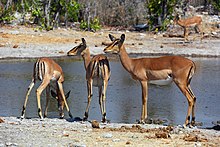Watering hole
 From Wikipedia the free encyclopedia
From Wikipedia the free encyclopedia

A watering hole or waterhole is a geological depression in which a body of water forms, usually a pond or a small lake. A watering hole is "a sunken area of land that fills with water".[1]
Watering holes may be ephemeral or seasonal. Ephemeral rivers sometimes form waterholes in geological depressions or areas scoured by erosion, and are common in arid regions of Australia.[2][3] In Australia, the term "billabong", often defined as a type of oxbow lake (an isolated crescentic pond left behind after a river loop is cut off when the river channel changes course),[4] is also used to refer to other types of waterholes.[5][6] While they exist in both wetlands and arid lands, they are of particular importance in desert areas of Australia, where they are often the only water source for native animals, people, and livestock, and provide critical habitat for a number of wildlife species. Their existence is being threatened by climate change.[7] Desert waterholes are often found in dry hilly areas, sustained by discharge of groundwater, remaining for long periods after flood events or normal flows of rivers and creeks. Depending on the climate, they can be permanent or semi-permanent depending on climatic conditions. They are of particular importance to Indigenous Australians in desert areas, providing water to the local population as well as attracting animals which are used as food, and sustaining plants which can be used for food (bush tucker), bush medicine, tools, shelter, and clothing.[8] They may also be of cultural significance, as places to conduct ceremonies, and are usually named and part of their jukurrpa (Dreaming) stories.[9]
Another process by which waterholes may be formed is from elephants digging up termite mounds for nutrients in the soil, repeatedly digging at the same location until a depression large enough to hold a substantial amount of water.[10]
In Africa, animals often gather at waterholes to drink the water. A common misconception associated with watering holes is that, due to the common need for water, predator animals will not attack prey animals in the vicinity of the watering hole. This trope was exploited, for example, by Rudyard Kipling in The Jungle Book, which describes a "truce" at the watering hole as a plot point.[11] In fact, it has been observed that "lions usually ambush their prey by hiding in long grass, often in close proximity to a watering hole".[12]
One study noted that watering holes can serve as a locus of disease transmission, and observed that "all animals displayed some degree of increased watering hole use with at least one metric of decreased water availability, suggesting that drying environments may contribute to increased parasite concentration at these hotspots across species".[13]
References[edit]
- ^ Susan Hoe, "Mapping a Watering Hole in Australia", Habitats (2008), p. 18.
- ^ Cockayne, Bernie (2021). "Climate change effects on waterhole persistence in rivers of the Lake Eyre Basin, Australia". Journal of Arid Environments. 187. Elsevier BV: 104428. doi:10.1016/j.jaridenv.2020.104428. ISSN 0140-1963.
- ^ "The Wondrous Waterholes of Northern Australia". Australian River Restoration Centre. 4 December 2015. Retrieved 9 February 2024.
- ^ "Rivers Continuing in Time". Burarra Gathering. Wurdeja, Ji-malawa and Yilan Aboriginal Communities. 21 June 2006. Archived from the original on 10 May 2013. Retrieved 10 April 2013.
- ^ "Queensland Waterhole Classification Scheme (Department of Environment, Science and Innovation)". Queensland Government. Department of Environment, Science and Innovation. 14 January 2020. Retrieved 9 February 2024.
- ^ Larsen, Joshua; Nanson, Gerald; Jones, Brian (20 November 2009). "Billabongs (waterholes), unique geomorphology and hydrology in action in arid Australia". Vignette Collection. Retrieved 9 February 2024.
- ^ "Waterholes as critical features of dry land river systems". Research Plus. 9 May 2020. Retrieved 9 February 2024.
- ^ "Groundwater". Indigenous Knowledge Institute. 28 May 2020. Retrieved 10 February 2024.
- ^ "Sacred waterholes of the Western Desert". The Nature Conservancy Australia. 8 May 2023. Retrieved 10 February 2024.
- ^ "The Elephant and the Termite". PBS. 3 November 2021.
- ^ Truitt, Brian (12 April 2016). "Review: CGI animals are the real treat of 'Jungle Book'". USA Today.
- ^ Andrew Ferguson Fraser, Feline Behaviour and Welfare (2012), p. 67.
- ^ Georgia Titcomb, "The role of watering holes as hotspots of disease transmission in changing climates", U.C. Santa Barbara (2020).